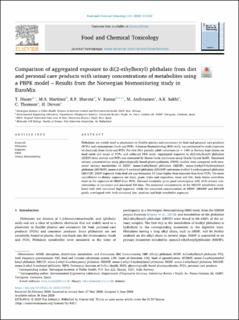| dc.contributor.author | Husøy, Trine | |
| dc.contributor.author | Martinez, M.A. | |
| dc.contributor.author | Sharma, R. P. | |
| dc.contributor.author | Kumar, V. | |
| dc.contributor.author | Andreassen, Monica | |
| dc.contributor.author | Sakhi, Amrit Kaur | |
| dc.contributor.author | Thomsen, Cathrine | |
| dc.contributor.author | Dirven, Hubert | |
| dc.date.accessioned | 2021-03-10T06:51:22Z | |
| dc.date.available | 2021-03-10T06:51:22Z | |
| dc.date.created | 2021-01-25T13:32:20Z | |
| dc.date.issued | 2020 | |
| dc.identifier.citation | Food and Chemical Toxicology. 2020, 143 . | |
| dc.identifier.issn | 0278-6915 | |
| dc.identifier.uri | https://hdl.handle.net/11250/2732475 | |
| dc.description.abstract | Phthalates are widely used as plasticisers in flexible plastics and containers for food and personal care products (PCPs) and contaminates foods and PCPs. A human biomonitoring (BM) study was performed to study exposure of chemicals from foods and PCPs. For two 24-h periods, adult volunteers (n = 144) in Norway kept diaries on food eaten and usage of PCPs, and collected 24-h urine. Aggregated exposure to di(2-ethylhexyl) phthalate (DEHP) from dietary and PCPs was estimated by Monte-Carlo simulation using Oracle Crystal Ball©. Simulated urinary concentrations using physiologically based pharmacokinetic (PBPK) models were compared with measured urinary metabolites of DEHP, mono-2-ethylhexyl phthalate (MEHP), mono-2-ethyl-5-hydroxyhexyl phthalate (MEHHP), mono-2-ethyl-5-oxohexyl phthalate (MEOHP) and mono-2-ethyl 5-carboxypentyl phthalate (MECCP). DEHP exposure from food are approximately 10 times higher than exposure than from PCPs. The main contributors to dietary exposure are dairy, grain, fruits and vegetables, meat and fish. Body lotion contribute most to the exposure of DEHP from PCPs. Forward-dosimetry gives good convergence with 24-h urinary concentrations of simulated and measured BM data. The measured concentration of the MECCP metabolite correlated well with simulated high exposure, while the measured concentrations of MEHP, MEHHP and MEOHP partly overlapped with both simulated low, medium and high metabolite exposure. | |
| dc.language.iso | eng | |
| dc.relation.uri | https://www.sciencedirect.com/science/article/pii/S0278691520304002?via%3Dihub#! | |
| dc.title | Comparison of aggregated exposure to di(2-ethylhexyl) phthalate from diet and personal care products with urinary concentrations of metabolites using a PBPK model – Results from the Norwegian biomonitoring study in EuroMix | |
| dc.type | Peer reviewed | |
| dc.type | Journal article | |
| dc.description.version | publishedVersion | |
| dc.source.pagenumber | 11 | |
| dc.source.volume | 143 | |
| dc.source.journal | Food and Chemical Toxicology | |
| dc.identifier.doi | 10.1016/j.fct.2020.111510 | |
| dc.identifier.cristin | 1878457 | |
| cristin.ispublished | true | |
| cristin.fulltext | original | |
| cristin.qualitycode | 1 | |
